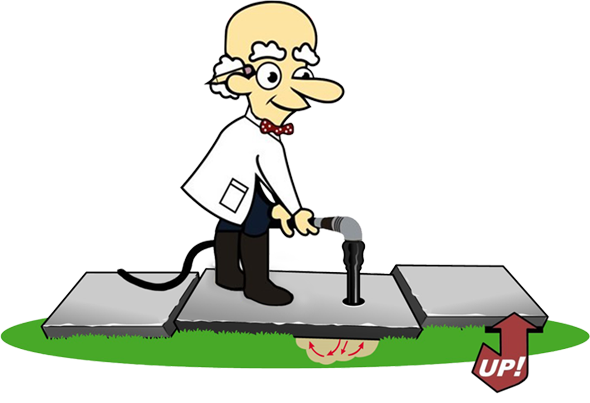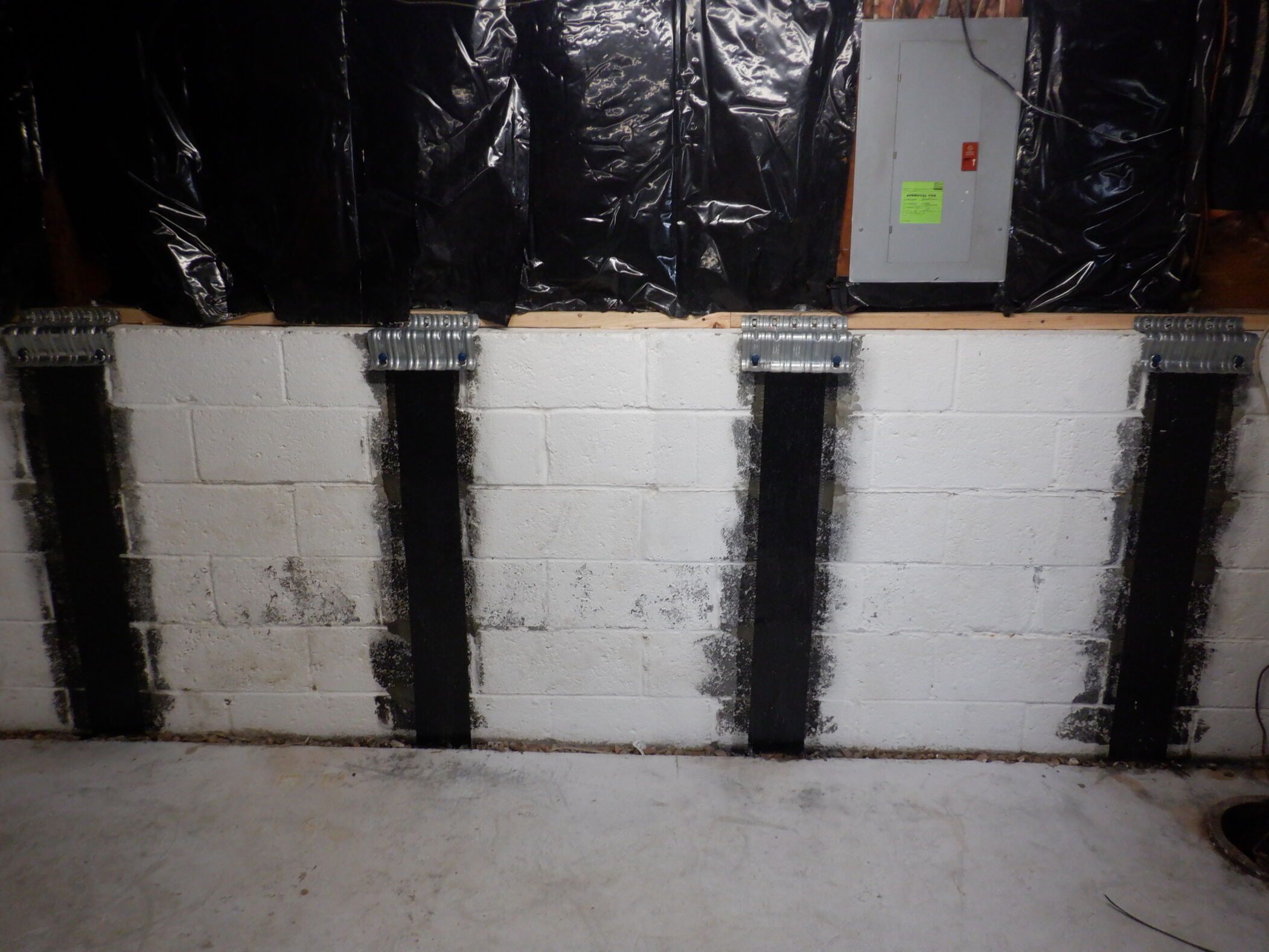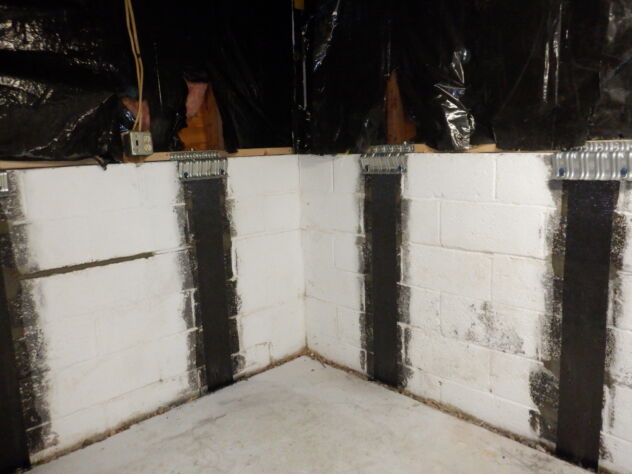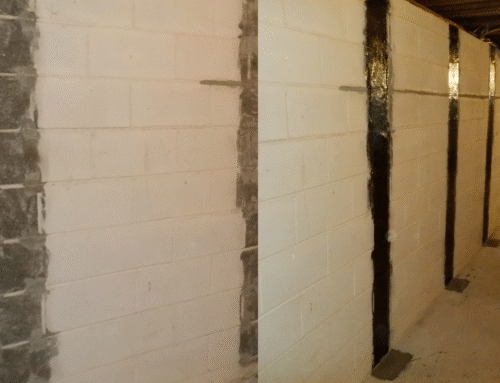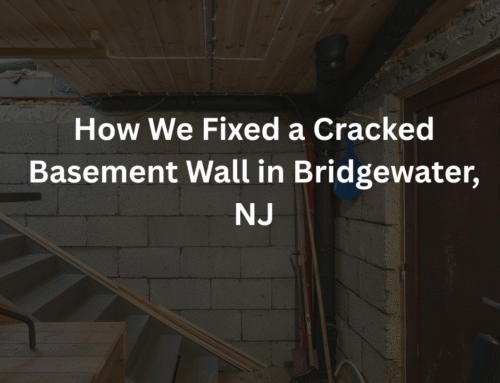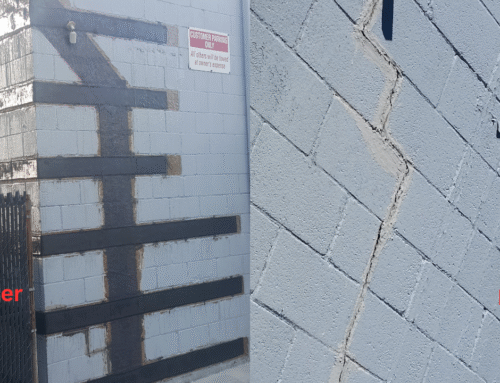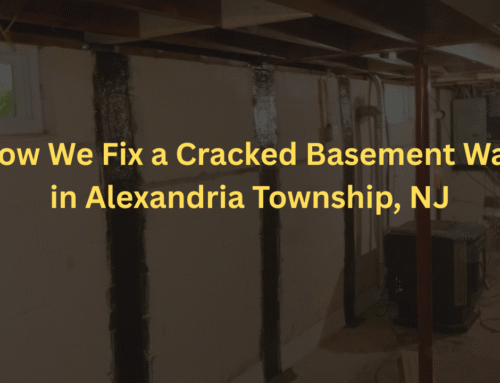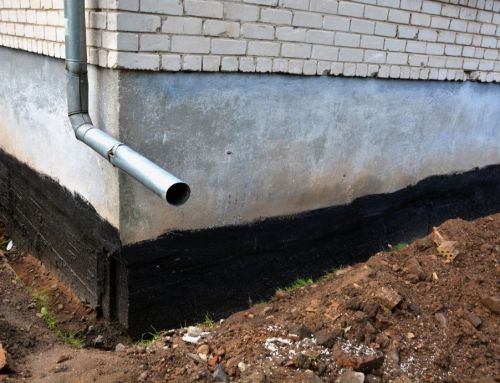IN THIS ARTICLE
This is how we fixed a cracked Basement Wall with Carbon Fiber Straps in Raritan, NJ
Basement walls don’t suddenly crack or bow overnight. It often happens slowly, sometimes over years, until one day you notice a long horizontal line running across the blocks or the wall starts to lean slightly inward. That was the situation for a homeowner in Raritan, New Jersey.
They noticed their basement wall wasn’t looking right — it had several visible cracks and a slight inward bend. Nothing had fallen apart yet, but they could tell it was getting worse. The paint was flaking near the crack, and a few of the blocks looked like they were shifting. That’s when they decided it was time to reach out for help.
How the Homeowner Found Us
Like many of our clients, they went straight to Google to look for answers. They searched for terms like “cracked basement wall repair in New Jersey” and “how to fix a bowing block wall”. After browsing through some results, they found our website and read about our carbon fiber repair method. It sounded practical, clean, and not too invasive — exactly what they wanted.
They gave us a call and shared a few clear photos of the damaged wall. We don’t usually visit sites in person because we’ve found that good-quality photos are often enough to assess what’s going on. From pictures, we can see the wall pattern, crack type, which allows us to give an accurate evaluation and cost estimate, before an on-site visit, free of charge.
Once we saw their photos, it was clear that this was a typical bowing wall problem caused by hydrostatic pressure — that’s the constant pressure of wet soil pushing against the foundation from the outside. Over time, that pressure can cause concrete block walls to curve inward and crack horizontally.
What We Decided to Do
After reviewing everything, we recommended carbon fiber wall reinforcement. It’s a permanent repair method that doesn’t require excavation or major demolition. Instead, it strengthens the existing wall by bonding high-strength carbon fiber straps directly to the surface, effectively stopping further movement.
For this Raritan home, we planned to install multiple vertical carbon fiber straps, each anchored at the top and bottom. The goal wasn’t just to cover the cracks — it was to stabilize the wall and bring back its original strength.
Step 1: Preparing the Wall
Before anything else, the surface needed to be properly prepared. We asked the homeowner to clear the area so we could work freely. Once on site, we cleaned off dust, loose paint, and debris using grinders. This step is important because carbon fiber and epoxy need a clean, solid surface to bond correctly.
While prepping, we also marked where each strap would go — typically spaced every four feet across the wall. These positions correspond to where the most pressure or deflection usually occurs.
Step 2: Applying the Epoxy
With the wall cleaned and marked, we began applying a high-strength epoxy resin. This resin acts like a powerful adhesive that permanently bonds the carbon fiber to the wall. We spread it evenly along each vertical section, making sure it penetrated well into the block texture.
Step 3: Installing the Carbon Fiber Straps
Once the epoxy was ready, we carefully positioned each carbon fiber strap and pressed it firmly into place. These straps are extremely thin but incredibly strong — stronger than steel when it comes to tension. Once bonded, they create a continuous vertical support that resists further inward movement.
Each strap was smoothed out to remove air bubbles and ensure full contact with the wall.
Step 4: Anchoring the Straps
Unlike some other methods, we use top anchor brackets to give the repair even more strength. At the top, we secure the straps to the sill plate with heavy-duty steel anchors. At the bottom, the straps are bonded tightly to the floor.
This creates a full load path from top to bottom, preventing the wall from moving even if the surrounding soil continues to expand or contract.
Step 5: Curing and Finishing
After the straps were installed, we allowed the epoxy to cure fully. The finished wall looked neat — just clean, vertical black bands across the block surface. The homeowner could paint over it later if they wanted, but most leave it as-is since it already looks clean and strong.
We also checked that the cracks were fully sealed and no gaps remained. Once everything hardened, the wall was back to being structurally sound.
Why Carbon Fiber Wall Strap Repair Was the Right Choice
A lot of homeowners worry that once a basement wall starts to bow, the only solution is an expensive full replacement. That’s not always true. If caught early enough, carbon fiber repair is one of the best ways to stop movement without tearing up your yard or digging around the foundation.
Here’s why it works so well:
- Strength: Carbon fiber is stronger than steel but weighs almost nothing.
- No Excavation: Everything is done from the inside of the basement.
- Low Profile: The straps are thin and don’t take up space like steel beams.
- Permanent Solution: Once installed, the wall is reinforced for life.
This Raritan home is a good example of how effective the method is. The wall was stabilized without excavation, without noise, and without a mess.
What We Noticed About This Wall
During installation, it was easy to see where the wall had been bowing the most — usually near the middle section between the floor and the sill plate. This is common with block walls because that’s where lateral soil pressure hits hardest.
Cracking followed the typical horizontal pattern, but there were also small vertical splits near the corners. That combination told us the wall had been under steady outward pressure for quite some time. Luckily, the owner caught it before it got worse.
Once reinforced with carbon fiber, the wall was fully stabilized and ready for normal use. The homeowner said they felt a lot more confident finishing the basement after the work was done.
Lessons from the Raritan Project
If there’s one takeaway from this project, it’s that early action saves you from bigger problems later. Bowing and cracked walls never fix themselves. The longer they’re left alone, the more pressure builds, and that can eventually lead to a full structural failure.
But with the right approach — in this case, carbon fiber reinforcement — you can secure the foundation without major disruption.
Final Thoughts
For this Raritan, NJ home, a few photos were all it took for us to assess the situation, recommend a plan, and carry out a permanent repair. No digging, no guesswork, and no unnecessary costs.
If your basement wall looks similar — cracked, bowing, or leaning inward — don’t panic. Just take a few clear photos and send them over. We’ll review them and tell you exactly what’s going on, along with a free estimate.
At Concrete Chiropractor, we’ve been repairing concrete walls and floors across New Jersey and Eastern Pennsylvania for more than 25 years, helping homeowners restore stability and peace of mind using proven, modern techniques like carbon fiber reinforcement. Contact us for a Free evaluation.
- How We Repaired a Cracked Basement Wall in Raritan, NJ - October 26, 2025
- How We Repaired a Bowing Concrete Block Wall in Hillsborough, NJ - October 25, 2025
- How We Fix a Cracked Concrete Block Wall at B & G Gulf in Holmdel, NJ - October 23, 2025

